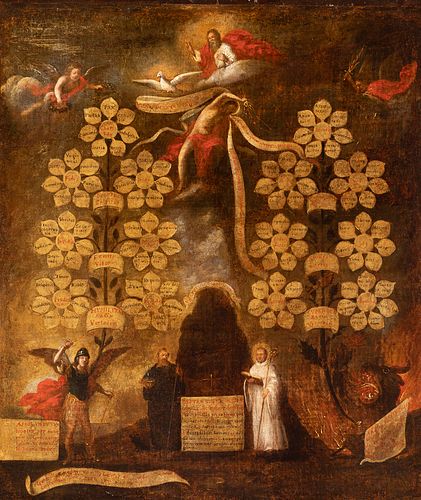Andalusian or Novo-Hispanic school; end of the 17th century. "The theological virtues and the deadly sins". Oil on canvas. Relined.
Lot 69
About Seller
Setdart Auction House
Carrer Aragó 346
Barcelona
Spain
Setdart Subastas was born in 2004 and is currently the first online art auction in Spain with solidity, prestige and reliability guaranteed by our more than 60,000 users. Setdart has a young, dynamic and enterprising team ready to successfully manage the purchase and sale of art works through custom...Read more
Estimate:
EUR€5,000 - EUR€7,000
$5,376.34 - $7,526.88
Absentee vs Live bid
Two ways to bid:
- Leave a max absentee bid and the platform will bid on your behalf up to your maximum bid during the live auction.
- Bid live during the auction and your bids will be submitted real-time to the auctioneer.
Bid Increments
| Price | Bid Increment |
|---|---|
| EUR€0 | EUR€10 |
| EUR€200 | EUR€25 |
| EUR€500 | EUR€50 |
| EUR€1,000 | EUR€100 |
| EUR€3,000 | EUR€200 |
| EUR€5,000 | EUR€500 |
| EUR€10,000 | EUR€1,000 |
| EUR€20,000 | EUR€2,000 |
| EUR€50,000 | EUR€5,000 |
About Auction
By Setdart Auction House
Nov 3, 2021
Set Reminder
2021-11-03 08:00:00
2021-11-03 08:00:00
America/New_York
Bidsquare
Bidsquare : OLD MASTERS
https://www.bidsquare.com/auctions/setdart-auction-house/old-masters-7786
Setdart Auction House sofia@setdart.com
Setdart Auction House sofia@setdart.com
- Lot Description
Andalusian or Novo-Hispanic school; end of the 17th century. "The theological virtues and the deadly sins". Oil on canvas. Relined. Measurements: 72 x 62 cm; 94 x 84 cm. Through the use of a pyramidal composition, the author conceives a landscape where numerous symbols of Christianity come together. In the first place, located in the upper zone in the center of the scene the figure of God the Father, dressed in white with red mantle, adopting the gesture of blessing. This is the most relevant representation of the scene, because the others start from him. Under his lap the dove of the Holy Spirit, and the figure of Jesus. From the body of Christ, dressed only with a red cloth in allusion to the martyrdom, different legends that are connected with two arboreal structures, conceived as a floral bouquet. In each of them, located at the ends of the canvas, are arranged the virtues (Faith, hope and charity (theological) and prudence, temperance, justice and fortitude (cardinal), while in the other can be seen the deadly sins (lust, anger, laziness, envy, pride, gluttony and greed). The scene ends, located in the earthly realm, with the figure of an archangel and several religious, accompanied by ornaments with writing inside. This type of works were used in a pedagogical way, with the intention of evangelizing and spreading the word of Christianity. For this reason, a schematic compositional pattern can be appreciated, based on the foreground and the symmetrical division of space. An example of the interest in representing the virtues and the deadly sins, facing each other, is the work of Giotto, located in the chapel of the Scrovegni in Padua. It is worth mentioning that, during the Spanish colonial domination, a mainly religious painting was developed, aimed at Christianizing the indigenous peoples. The local painters were modeled on Spanish works, which they followed literally in terms of types and iconography. The most frequent models were the harquebusier angels and the triangular virgins, however, in the first years of the 19th century, already in times of independence and political opening of some of the colonies, several artists began to represent a new model of painting with its own identity.
- Shipping Info
-
In-house shipping available. Please inquire at admin@setdart.com.
-
- Buyer's Premium



 EUR
EUR CAD
CAD AUD
AUD GBP
GBP MXN
MXN HKD
HKD CNY
CNY MYR
MYR SEK
SEK SGD
SGD CHF
CHF THB
THB















